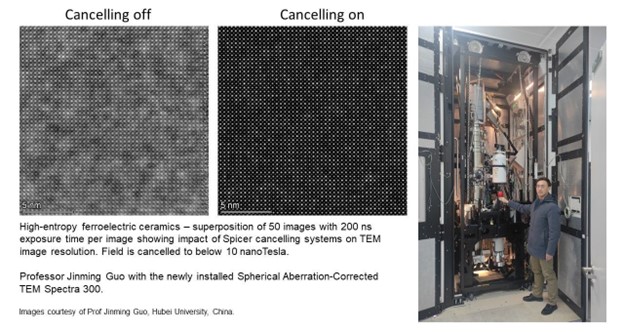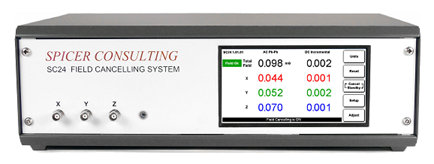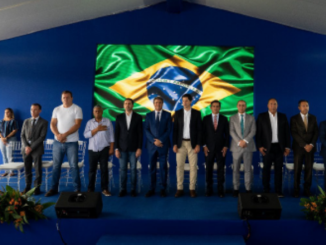
Magnetic field interference can be a vexing problem for an electron microscope operating at high levels of magnification, limiting the quality and resolution of the images generated. One mitigation, of course, can be to place the instrument in a “quiet” location but that may not be practical nor best serve the workflow. Fortunately, dedicated magnetic field cancelling systems can be employed to actively eliminate external fields, allowing microscopes to perform to their specifications, producing high resolution images even in challenging locations.
A recent case study from Spicer Consulting Ltd. in the UK illustrates how its dual (2x) magnetic cancelling system is assisting in the atomic level study of ferroelectric materials at Hubei University in China. In the report, Jinming Guo, Professor of Materials Science & Engineering, describes the application of the dual SC24 system.
Ferroelectric materials are dielectric substances that remain permanently polarized after the removal of an applied electric field; they are routinely used in applications ranging from energy conversion to data storage. The School of Materials Science and Engineering at Hubei University has an active ferroelectric research program, largely focused on understanding the relationship between the microstructures and macroscopic properties of these valuable substances.
Prof. Guo explained: “We employ transmission electron microscopy (TEM) to study ferroelectric materials at the atomic scale, allowing us to gain valuable insights into the key mechanisms responsible for their unique characteristics. For example, we can use TEM to determine the polarization vectors in perovskite unit cells. The relative displacement of ions that occur in these structures is in the order of tens of picometers, so such minute changes are only detectable at an instrument’s highest magnification and resolution settings.”
Unfortunately, the laboratory is just 70 meters away from a sandwich-structure road network containing a busy metro line (underneath), a high street and an overpass, which generates a large magnetic field with a strong gradient, causing intolerable levels of image distortion. Prof. Guo highlighted the scale of this problem: “To put this issue into perspective, our Thermo Scientific Spectra 300 TEM is rated to withstand external fields of up to 20 nanoTesla (nT), but the field generated by the subway is almost 4,000 nT – orders of magnitude higher than the acceptable limits. Such intense and non-uniform magnetic field interference was, therefore, severely compromising image quality, making our research activities extremely difficult. While passive shielding provided us with some protection against AC fields, we were still in need of a solution for our DC field problems.”
After installing the system, the external interference dropped to well within the manufacturer specified range, and all values at X, Y, Z directions ranging from height of 3 meters to 0.5 meters are below 20 nanoTesla obtained by 4 detectors, allowing it to operate at its highest magnification and resolution levels with no issues from magnetic interference, reports Prof. Guo. “The SC24 system is also incredibly easy to use, and it is remarkable to see the real-time difference in image quality when switching the unit on and off.”

Spicer’s magnetic field cancelling systems protect electron beam instruments including SEMs, transmission electron microscopes, electron beam lithography tools and SEM-based metrology and inspection tools. They are located in some of the world’s leading laboratories, universities, semiconductor manufacturing plants and test facilities of electron and ion beam equipment manufacturers.
Each system is comprised of a magnetic field control unit, one or more magnetic field sensors and three multicore cables, which are installed around the microscope for which the field is to be cancelled. Three power amplifiers in the control unit drive currents through the cables to create a field of the opposite sign to the change in ambient field. The sensor measures the resulting field and real time negative feedback reduces the ambient field by the loop gain of the system. The systems can be added to or replace passive magnetic field shielding. Dual sensors can be mixed to create a virtual sensor “inside” the EM column, useful for large TEMs or where there is a high field gradient.
For more info and to see the complete case study, visit www.spicerconsulting.com.



